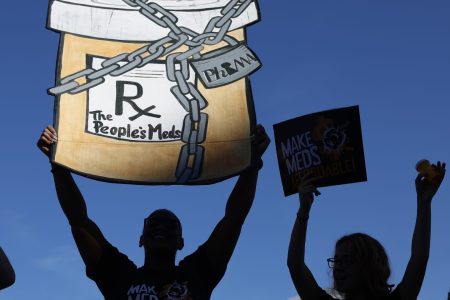Activists protest the price of prescription drug costs in front of the U.S. Department of Health and Human Services building in Washington, D.C., on Oct. 6, 2022.
Anna Moneymaker | Getty Images
The Biden administration on Thursday released prices for the first 10 prescription drugs that were subject to landmark negotiations between drugmakers and Medicare, a milestone in a controversial process that aims to make costly medications more affordable for older Americans.
The government estimates that the new negotiated prices for the medications will lead to around $6 billion in net savings for the Medicare program in 2026 alone when they officially go into effect, or 22% net savings overall. That is based on the estimated savings the prices would have produced if they were in effect in 2023, senior administration officials told reporters Wednesday.
The Biden administration also expects the new prices to save Medicare enrollees $1.5 billion in out-of-pocket costs in 2026 alone.
“For so many people, being able to afford these drugs will mean the difference between debilitating illness and living full lives,” Chiquita Brooks-LaSure, administrator for the Centers for Medicare & Medicaid Services, told reporters. “These negotiated prices. They’re not just about costs. They are about helping to make sure that your father, your grandfather or you can live longer, healthier.”
It comes one day before the second anniversary of President Joe Biden‘s signature Inflation Reduction Act, which gave Medicare the power to directly hash out drug prices with manufacturers for the first time in the federal program’s nearly 60-year history.
Here are the negotiated prices for a 30-day supply of the 10 drugs, along with their list prices based on 2023 prescription fills, according to a Biden administration fact sheet Thursday.
What Medicare and beneficiaries pay for a drug is often much less than the list price, which is what a wholesaler, distributor or other direct purchaser paid a manufacturer for a medication before any discounts.
Notably, it is difficult to compare the new negotiated price of a drug with its current list price. That’s because most of the 10 medications are already subject to significant rebates after private negotiations with Medicare Part D plans.
But the heavily rebated net price that Part D plans pay for a given drug is unknown since those talks are confidential, according to Leigh Purvis, a prescription drug policy principal with the AARP Public Policy Institute. AARP, the influential lobby group that represents people older than 50, has advocated for Medicare’s new negotiation powers.
“So that’s I think what people are going to be trying to get to – are these negotiated prices lower than the net prices that Medicare Part D were already paying?” Purvis told CNBC. “And so that’s the comparison that people are looking for. Now, recognizing that rebates are confidential, it’s going to be a tough ask.”
A senior administration official confirmed that a…
Read More: Medicare releases prices for first 10 drugs subject to negotiations

